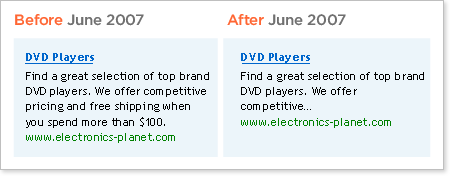 In April I posted about the impending truncation of Yahoo! ad texts: well, the time is nigh. Ad texts that are over 70 characters in length will be truncated when displayed within Yahoo!’s SERP. Here is a visual example of how your ad will be effected by this ad delivery alteration (borrowed from the YSM blog):
In April I posted about the impending truncation of Yahoo! ad texts: well, the time is nigh. Ad texts that are over 70 characters in length will be truncated when displayed within Yahoo!’s SERP. Here is a visual example of how your ad will be effected by this ad delivery alteration (borrowed from the YSM blog):

Consumers have countless reasons not to click on your ad, and you shouldn’t give them another one by not displaying clear, concise, enticing ad text.
So, how do you go about revising your ad texts so that they convey information about your product, service and company while peaking users’ interest so that they click on your ad, all the while still fitting within the prescribed character count? Here are a few thing to keep in mind when composing a PPC ad text:
- Keywords are the key. Utilize your high-traffic, high-converting keywords in the headline and body text (and if you can’t fit your top keyword in both, make sure these keywords at least appear in your headline). You can use dynamic keyword insertion (DKI) to make sure that all of your keywords appear within your ad, and you should certainly test this method, but you should be able to create static ad texts that focus on your ad groups’ main keywords without DKI. However, if you find that you are having to use DKI to make your ads relevant, you may need to work your on your account structure.
- Focus on your most important benefits. Free shipping, same-day shipping, wide selection, excellent customer service, industry-leading expertise in your field, discount prices, free information, hard-to-find items; decide is what most important to your customers and highlight these benefits in your ad text. If you are creative you will be able to fit two benefits in your ad (one in the headline, one in the body text and you’re done!). Drop everything else. Note: Whatever benefits you decide to highlight in your ad text, make sure they are also featured on your landing page! If someone is enticed by discount prices, make sure you support this promise when they get to your site.
- Be the answer. Essentially, when a user types in a query they are looking for an answer to a problem. The solution could be a specific service, product or piece of information. Think about what problems your audience has, how you can solve that problem, and then determine how you can present the best solution in 70 characters or less. Show the user that you are relevant to their problem by highlighting the correct keywords, and solve their problem by conveying the benefits you have to offer. This is how you become the answer.
When you focus on your high-traffic keywords and on one/two benefits then you’ll be able to trim that ad fat down to 70 characters in no time. Just remember to be relevant to a searcher’s problem, and be the solution.



